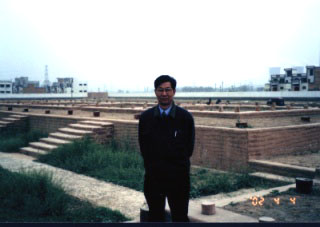Bai Yunxiang
Deputy director of the Institute of Archaeology, Chinese Academy of Social Sciences (IACASS)
Born in the December of 1955 in Zibo, Shandong Province, Bai graduated from the Archaeology Program, Department of History, Shandong University in 1978 and entered the IACASS in the same year. As a member of the Jingwei Fieldwork Team of the IACASS, he had joined several fieldwork from 1978 to 1982 in the Shaanxi and Gansu Provinces. He started his editor career in 1983 as an editor of Kaoguxuebao, and became the head of the editorial board of Kaogu later. Thanks for his management, Kaogu won the National Reward of Outstanding Journals of Social Sciences in 1995, and entered the list of One Hundred Major Journals of Social Sciences in 1998. He stayed in Japan at the Tukuba University and the Nara Institute of Silk-road Study in 1990 and 1994 as a guest scholar. In 1999, he begun to give lectures as a professor on Archaeology of the Qin and Han Dynasties in the Department of Archaeology, Graduated School of Chinese Academy of Social Sciences and became a supervisor of MA candidates of the School. He is now the deputy director of the IACASS, deputy chief editor of Kaogu and Chinese Archaeology (an English journal of the IACASS published annually). His major research interests are function of ancient tools, archaeology of the Qin and Han Dynasties and cultural exchange between China and the outside world in prehistoric and historical time.
Main fieldwork:
1982: the excavation at Luoyang, the ancient capital city of the Sui and Tang Dynasties.
1980-1981: the excavations at the Nianzipo site, Changwu County, Shaanxi Province. A large number of houses and burials of the pre-Zhou period were found in the excavations, which had greatly improved the study on pre-Zhou cultures.
1980: the excavation at the Xujianian site, Zhuanglang County, Gansu Province. A cemetery of 104 burials of the Siwa culture were found. It is by present the largest Siwa cemetery and significant for the study on chronology, burial rituals, cultural characteristics and social structures of the culture.
1979: the excavation at the Changshan site, Zhenyuan County, Gansu Province. The excavation discovered a new archaeological culture centered in the Longdong area, which was named the Lower Changshan culture afterwards. Cave dwellings unearthed in the excavation was also new to archaeologists at that time.
After his first paper in Kaogu in 1984, Bai have published more than 40 papers, 2 books and more than 10 translations. His major publications include:
2002: Ershi shiji Zhongguo baixiang kaogu dafaxian (One hundred important archaeological discoveries in China in the 20th Century), Beijing: Zhongguo shehuikexue chubanshe.
2001: “Handai Zhongguo yu Chaoxian guanxi de kaoguxe kaocha” (An archaeological research on the relationship between China and Korea Peninsula in the Han Dynasty), Beifang wenwu: 4.
2001: “Zhanguo Qinhan shiqi wengguanzang yanjiu” (Research on the urn-burials in the Warring States Period and the Qin and Han Dynasties), Kaoguxuebao: 3.
2000: Minju jianzhu shihua (Brief history of civilian architectures), Beijing: Zhongguo dabaikequanshu chubanshe.
1999: “Xihan shiqi riguangdaming caoyewenjing jiqi zhufan de kaocha” (Research on the Western Han Dynasty bronze mirrors with the inscriptions ‘riguangdaming’ and grass-blade patterns and their molds), Kaogu: 4. (the paper won the 2001 Outstanding Research Reward of the Chinese Academy of Social Sciences)
1999: “Xianggang gudai shehui de kaoguxue kaocha” (An archaeological study on ancient societies in Hong Kong), Kaoguxuejikan: 12.
1994: On the Early City and the Beginning of the State in Ancient China, BULLETIN OF THE ANCIENT ORIENT MUSEUM, VOL.XV,PP.1--22.
1993: “Zhanguo Qinhan he Riben Misheng shidai de duanqiong tieqi” (Forged iron objects of the Warring States Period and the Qin and Han Dynasties in China and the Yayoi Period in Japan), Kaogu: 5.
1988: “Shilun shiren guqi” (Brief research on bone tools with stone blades), Kaogu: 9.
1986: “Shilun Zhongguo gudai de ju” (Brief research on the saw in ancient China), Kaogu yu wenwu: 3 and 4.
1985: “Chiren tonglian chulun” (Brief research on the bronze toothed-sickle), Kaogu: 3.
1985: “Yindai Xizhou shifou daliang shiyong qingtong nongju de kaoguxue guancha” (An archaeological research on whether bronze agricultural tools had been widely used in the Shang and Western Zhou Dynasties), Nongyekaogu: 1.
1984: “Tang Zhanghuai taizi mu bihua keshitu zhong ‘Riben shijie’ zhiyi” (Questions on the ‘Japanese ambassadors’ on the mural in the tomb of Prince Zhanghuai of the Tang Dynasty), Kaogu: 12.

